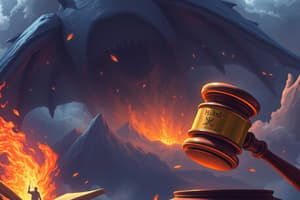Podcast
Questions and Answers
What is the significance of the Waldbaum v. Fairchild Publications, Inc. case in defining limited-purpose public figure status?
What is the significance of the Waldbaum v. Fairchild Publications, Inc. case in defining limited-purpose public figure status?
The Waldbaum v. Fairchild Publications, Inc. case is influential in defining limited-purpose public figure status, where a former chief executive was considered a limited-purpose public figure due to the coverage of his innovative business model and his impact on industry policies.
How do court decisions contribute to the variations in public figure formulations across lower federal courts?
How do court decisions contribute to the variations in public figure formulations across lower federal courts?
Court decisions have found individuals like Grammy-winning recording artists and NFL players to be public figures due to their widespread recognition and involvement in highly publicized events, contributing to variations in public figure formulations across lower federal courts.
Explain the concept of public figure status in defamation law and how it impacts defamation claims.
Explain the concept of public figure status in defamation law and how it impacts defamation claims.
Public figure status in defamation law determines whether a plaintiff must prove actual malice for a defamation claim. It is determined by the judge as a question of law and can be general-purpose or limited-purpose. General-purpose public figure status is typically reserved for widely recognized individuals or organizations, while limited-purpose public figure status varies among courts.
Explain the potential impact of social media on the phenomenon of 'callout culture' and the risk it poses for innocent individuals being falsely accused.
Explain the potential impact of social media on the phenomenon of 'callout culture' and the risk it poses for innocent individuals being falsely accused.
Discuss a specific example from the text where an individual was falsely accused due to misinformation spread through social media, and the resulting consequences.
Discuss a specific example from the text where an individual was falsely accused due to misinformation spread through social media, and the resulting consequences.
Examine the role of social media platforms in enabling ordinary individuals to reach large audiences, and the potential downsides associated with this empowerment.
Examine the role of social media platforms in enabling ordinary individuals to reach large audiences, and the potential downsides associated with this empowerment.
Explore the challenges and consequences of misidentification of wrongdoers in online spaces, drawing on examples from the text.
Explore the challenges and consequences of misidentification of wrongdoers in online spaces, drawing on examples from the text.
Discuss the potential implications of the empowering quality of social media platforms in the context of defamation and false accusations.
Discuss the potential implications of the empowering quality of social media platforms in the context of defamation and false accusations.
Flashcards are hidden until you start studying
Study Notes
Defamation Law and Public Figures
- The definition of a public figure in defamation law is complex and constantly evolving.
- Whether a plaintiff is considered a public figure who must prove actual malice for a defamation claim is determined by the judge as a question of law.
- General-purpose public figure status is typically reserved for widely recognized individuals or organizations, such as entertainment or sports celebrities, prominent corporations, or interest groups.
- The determination of limited, rather than general, public figure status varies among courts, with different approaches being applied.
- The Waldbaum v. Fairchild Publications, Inc. case is influential in defining limited-purpose public figure status, where a former chief executive was considered a limited-purpose public figure due to the coverage of his innovative business model and his impact on industry policies.
- The Gertz touchstone of a "public controversy" is understood to mean a situation with foreseeable and substantial ramifications for nonparticipants.
- An indicator of public-figure status is whether others alter their conduct or ideas in response to the plaintiff's actions.
- The Second Circuit modifies the Waldbaum approach by considering whether the plaintiff has access to the press.
- Court decisions have found individuals like Grammy-winning recording artists and NFL players to be public figures due to their widespread recognition and involvement in highly publicized events.
- The U.S. Supreme Court's failure to articulate a precise standard for determining a defamation plaintiff's status has led to variations in public figure formulations across lower federal courts.
- The driving public policy concern behind defamation law is to provide "breathing space" to the press, avoiding self-censorship and promoting aggressive reporting on powerful and litigious subjects.
- The law of libel aims to balance freedom of the press with protecting individuals from false and damaging statements.
Defamation Law and Public Figures
- The definition of a public figure in defamation law is complex and constantly evolving.
- Whether a plaintiff is considered a public figure who must prove actual malice for a defamation claim is determined by the judge as a question of law.
- General-purpose public figure status is typically reserved for widely recognized individuals or organizations, such as entertainment or sports celebrities, prominent corporations, or interest groups.
- The determination of limited, rather than general, public figure status varies among courts, with different approaches being applied.
- The Waldbaum v. Fairchild Publications, Inc. case is influential in defining limited-purpose public figure status, where a former chief executive was considered a limited-purpose public figure due to the coverage of his innovative business model and his impact on industry policies.
- The Gertz touchstone of a "public controversy" is understood to mean a situation with foreseeable and substantial ramifications for nonparticipants.
- An indicator of public-figure status is whether others alter their conduct or ideas in response to the plaintiff's actions.
- The Second Circuit modifies the Waldbaum approach by considering whether the plaintiff has access to the press.
- Court decisions have found individuals like Grammy-winning recording artists and NFL players to be public figures due to their widespread recognition and involvement in highly publicized events.
- The U.S. Supreme Court's failure to articulate a precise standard for determining a defamation plaintiff's status has led to variations in public figure formulations across lower federal courts.
- The driving public policy concern behind defamation law is to provide "breathing space" to the press, avoiding self-censorship and promoting aggressive reporting on powerful and litigious subjects.
- The law of libel aims to balance freedom of the press with protecting individuals from false and damaging statements.
Public Figures and Online Accusations
- The court applied the public-figure analysis in a libel suit involving the death of a woman who ingested drugs at a party.
- The controversy in the story was characterized as "possible drug dealing and drug use by public officials and their friends."
- Social media platforms empower ordinary people to reach large audiences without gatekeeping but also pose the risk of misfired accusations against the innocent.
- In 2017, a professor was wrongly identified as a participant in white supremacist rallies, leading to hate messages and death threats on social media.
- In 2020, a father and youth football coach was falsely identified on social media as the man who shot two Los Angeles County Sheriff deputies, resulting in death threats.
- A self-proclaimed online psychic used TikTok videos to falsely implicate a University of Idaho professor in the stabbing deaths of four students, leading to a defamation suit.
- Social media has given rise to "callout culture," where speakers try to expose and impose consequences on perceived wrongdoing, with #MeToo being an especially controversial subcategory.
- #MeToo websites have raised public awareness of sexual misconduct but are not typically subject to rigorous editing and fact-checking, raising the prospect of misidentification of wrongdoers.
- Accusations of unethical or illegal sexual behavior are propagating among localized Facebook groups seeking to expose unfaithful spouses or boyfriends.
- The phenomenon of online callout culture raises the risk that an innocent person may be misidentified as a wrongdoer, intentionally or accidentally.
- The empowering quality of social media platforms allows ordinary people to reach large audiences without the gatekeeping of corporate editors and publishers.
- Social media users sometimes race to judgment and misjudgment, leading to hate messages, death threats, and the need for individuals to hide out due to false accusations.
Studying That Suits You
Use AI to generate personalized quizzes and flashcards to suit your learning preferences.




